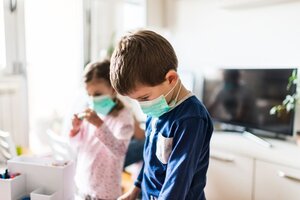New insights into COVID-19 protection in children have revealed the presence of sACE2 in the saliva
The presence of the soluble angiotensin-converting enzyme 2 (sACE2) in saliva could have implications for COVID-19 infection, prevention and control, according to researchers from the Institut de Recerca Sant Joan de Déu and the University of Catalunya. This study has been published in Scientific Reports.
The study, which was conducted by Drs. Pedro Brotons, Cristian Launes, and Carmen Muñoz-Almagro from Institut de Recerca Sant Joan de Déu (IRSJD) and SJD Barcelona Children's Hospital, in collaboration with Drs. Samuel Bru and Josep Clotet from the Faculty of Medicine and Health Sciences at UIC Barcelona, revealed that the levels of sACE2 in saliva may be associated with COVID-19 infection.
The investigation centered on a sample of families that resided in confined households during the spring of 2020 in the metropolitan area of Barcelona. It included adults who had previously experienced SARS-CoV-2 infection, as well as children who were cohabiting. Participants underwent tests to detect sACE2 and SARS-CoV-2 using Western blot and nasopharyngeal RT-PCR detection, respectively.
The presence of angiotensin-converting enzyme 2 (ACE2) in saliva of children and adults
The study examined saliva samples from 161 participants, including both children and adults, and found that 96.3% of the samples contained the soluble ACE2 protein. Furthermore, distinct forms of the protein were identified in the saliva of both infected adults and children, as well as in the saliva of non-infected children.
The ACE2 protein (angiotensin-converting enzyme 2) is found on the outer layer of numerous body organs, including the lungs. When the COVID-19 virus comes into contact with us, it binds to the ACE2 protein, thereby potentially entering our cells, replicating, and causing infection. ACE2 also plays a significant role in regulating blood pressure and inflammation in the body, which may have implications for the severity of COVID-19 disease.
This enzyme is also present in a soluble form, namely sACE2, which is released in small quantities into the bloodstream and other bodily fluids, such as saliva. sACE2 is not bound to cell surfaces and can circulate freely, unlike ACE2 in tissues. SARS-CoV-2 might be protected by sACE2 by binding to the virus and neutralizing it before it can infect cells.
"We observed that children who had not been infected by SARS-CoV-2 had a higher concentration of sACE2 in their saliva samples compared to infected children and adults," commented Dr. Carmen Muñoz, coordinator of the "Infectious Diseases and Microbiome" group at IRSJD and professor at the Department of Medicine at UIC Barcelona. "This could be another factor that may explain why children exhibited milder symptoms."
The implications of sACE2 levels in COVID-19 prevention and control are discussed
These findings suggest that the release of appropriate concentrations of sACE2 in saliva may possess a protective effect against SARS-CoV-2. Specifically, it has been observed that forms of the soluble protein have been predominantly identified in saliva of children.
The study authors emphasize that these findings could have significant implications for future virus research. It may be beneficial to investigate whether elevated levels of sACE2 can predict the risk of infection or serve as biomarkers for identifying individuals more susceptible to the infection.
"Our results are promising and indicate that measuring sACE2 levels in saliva could be a valuable tool for identifying individuals at higher risk of COVID-19 infection. Nonetheless, it is imperative that we conduct additional research to gain a deeper comprehension of the correlation between sACE2 levels and COVID-19 infection. Other factors such as age, gender, weight, and other biological factors may also influence sACE2 levels in saliva." concludes Dr. Pedro Brotons, researcher at IRSJD and professor at the Department of Medicine at UIC Barcelona.
Reference paper
Bru S, Brotons P, Jordan I, Alsina L, Henares D, Carballar R, de Sevilla MF, Barrabeig I, Fumado V, Baro B, Martínez-Láinez JM, Garcia-Garcia JJ, Bassat Q, Balaguer A, Clotet J, Launes C, Muñoz-Almagro C. Association between soluble angiotensin-converting enzyme 2 in saliva and SARS-CoV-2 infection: a cross-sectional study. Sci Rep. 2023 Apr 12;13(1):5985. doi: 10.1038/s41598-023-31911-2. PMID: 37045853; PMCID: PMC10092936.

Children who had not been infected with SARS-CoV-2 had a higher concentration of sACE2 in saliva samples than infected children and adults.
